The new Boeing 747-8F is one majestic aircraft. Along with all the majesticness (yes I just made that a word) comes a lot of weight. The 747-8F can take off weighing nearly one million pounds and for the flight tests, Boeing needs to make sure the aircraft can successfully complete an aborted take off, fully loaded.
The Ultimate Rejected Takeoff (yes that is official terminology) is not made easy. First they loaded up the aircraft to about 975,000 pounds. Then they made sure the brakes were as worn as possible — not something that would happen during normal maintenance.
Once the aircraft got above 200mph, the Boeing test pilot, Captain Kirk Vining, slammed on the brakes. During a normal aborted take off, the pilot would also use thrust reversers, but not for this test. All that energy (and it is a lot) went directly to the brakes.
The 747-8F was able to stop about 700 feet sooner than Boeing was expecting. However, stopping is just half the battle. As you can see in the video, once the aircraft is stopped, the brakes were glowing red. Even though a fire crew was on the scene, they let the brakes sit for five minutes to see how the 747-8F would react.
This video shows a worst case scenario. Even if you have experienced a rejected take off as a passenger, it most likely wasn’t this violent. This just goes to show that aircraft can handle a lot and are extremely safe.
For more information and a second video, check out Boeing’s website.
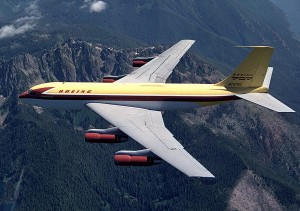
The Boeing 367-80 was the prototype for what became the KC-135 and the Boeing 707. Photo by Boeing.
This is the second part to my interview with Boeing Historian Michael Lombardi. Here is the continuation of our exclusive interview:
AirlineReporter (AR): What do you think the best decision Boeing has made?
Michael Lombardi (ML): I think the best decision was building the Dash 80 (the first Boeing 707), which was a huge risk. People like Bill Allen are such heroes of aviation because of this. They looked down the road and said ’œthe future will be jets.’ We built the B-47 and B-52 and the military has gone in this direction and commercial aviation cannot be too far behind, so let’s give them a little kick in the rear and get them going in that direction.
Boeing took company money and sunk it into building this prototype airplane (the dash 80), and if it had failed, the company would be done. That is why they think of it as a big gamble because financially they put everything into this and so now it was, now we got to make it work and everybody in the company really became focused on, ’œokay, this is the direction we are going, let’s make it happen’.
You have to remember that Boeing at this point is a military company, period. There is no commercial work at all. We are a military company. We are the sole supplier of bombers and missiles to the strategic air command. As a matter of fact, people used to think that SAC (Strategic Air Command) used to mean ’œSeattle Air Command’, because Boeing supplied B-52s, B-47s, Minuteman Missiles, KC97 Tankers, all of these things were invented and given to SAC.
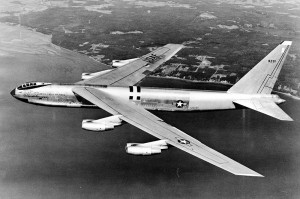
Boeing-made B-52 Stratofortress. Photo by US Air Force
AR: How did Boeing transition from military to commercial?
ML: Boeing told one engineer ’œokay, you go to Europe and sell our airplanes.’ Just one guy, and send him to Europe and tell him ’œgo’, and he’s like ’œI’m designing airplanes, what I am doing?’
There was a lot of learning that had to be done on a completely different business. You have a marketing department that all of a sudden had ’œoh, we have to deal with the public and with the airline customers, how do we do that?’
AR: Marketing must have had quite the challenge.
ML: Boeing had this great advertising campaign where they went right to the public, because they can’t get the airlines interested. So this campaign showed all of these people flying, taking away the fear out of it. Showing children sitting with their folks on the flights and focusing on how smooth a flight on a Boeing aircraft was.
With the older props, people would just wrap themselves in a blanket, get a pillow and wrap it around their heads and just endured the flight because of the vibration and the noise. There was a lot of romance, but there was also a lot to endure. Boeing said, we are going to get rid of all of that, and it’s going to be quiet and it’s going to be smooth, and it’s going to be fast and this is what you wanted people to say, ’œYeah, that’s what we want’.
Then you have Tex Johnson who did the barrel roll, doing his part to get people feeling that jets were safe’¦ that was the whole idea. Before that the British had come out with the Comet and it had a few problems. Because of the comets problems, coming apart at altitude, the public view of jets was that they were just not safe.
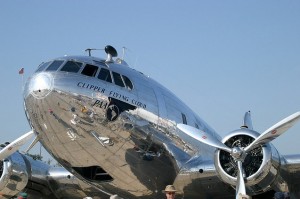
Boeing 307 Stratoliner gave Boeing much needed experience in cabin pressurization. Photo by Sam Wiltzius.
AR: The Comet had to make it hard to get people to trust jets were safe.
ML: The Comet’s problem is it had metal fatigue, the fuselage came apart altitude. This was because of the pressurization, the cycling of fuselage, Boeing had built the first world’s first pressure airplane back in the late 1930’s with the Stratoliner, so of course Boeing had been working on high altitude flight and pressurization for a couple of decades by the time the dash 80 came out.
Whereas de Havilland pretty much built trainer planes and the famous Mosquito during the war and they really didn’t have that much expertise in building big planes. They had gone too far too fast and they didn’t see this coming. The guys from Boeing had been doing their homework for years and developing all of this technology, so they understood all of these issues of cycling of fuselage.
As you remember, we had the Model 307 and the B-29 and the B-52. All of these pressurized planes had come out already.
AR: So how did the Boeing 707 come about?
ML: After the war, Bill Allen, who was running at the company at the time, said we need to diversify. We are too much into one direction with the military. We need to get into commercial, we need to get into space, missile and all of this, so he told his engineering department to start doing all these different things and part of the response was to take the model numbering system and say ’œokay, ’œyou guys working on military aircraft, here’s three and four hundred model numbers keep running with those. You guys over here working on turbine engines take these five hundreds and you guys working on missiles take six hundreds. And all of the work on new transport takes seven hundreds’.
Of course the first transport to come out was the 707 and they went with the 707 because it was catchy and it stuck. The bottom line is that everyone at Boeing focused on this and made it worked. In a few years Boeing turned from being a military company to being a balanced company, to having this commercial airplane business that we are still enjoying the success of today.
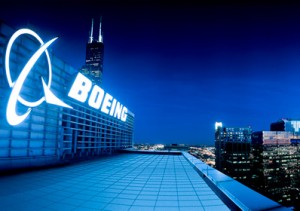
Boeing Headquarters in Chicago,IL. Photo by Boeing.
AR: What do you think was the biggest mistake Boeing made (or the greatest opportunity to learn)?
ML: I think the biggest mistake was when we were building the Boeing 247 and Douglas came out with the DC2 and DC3. We had a customer, TWA headed up by Jack Frye that came to Boeing and said ’œI want 247’s.’ Boeing had our corporate airline, United Air Lines, and they got first dibs. That meant the first 70 airplanes were promised to United Air Lines and when Jack Frye was desperate to have this new airplane for his new airline, he went to Douglas instead. Douglas then came out with the DC3, and the DC3 ended up putting Boeing out of the airliner business until the 707. Their big mistake, was not responding to that customer and they learned from that.
AR: Do you ever go on Wikipedia to make sure they have correct Boeing information?
ML: Every now and then I do. I usually very surprised how knowledgeable people are and there are some smart people out there and aviation enthusiast are passionate’¦ they’re smart, they know how to look stuff up and figure out those little details and the stuff is good. Sometimes I’ll read something and think, ’œWow, where did that come from?’
AR: Alright, my last question will be a doozie: What is the greatest misconception you think people have about Boeing?
ML: One of the things that always bugged me was the term ’œhigh tech company’ we are lead to think of high tech companies as being computer companies or software companies. But there are no other companies that are more high tech than aerospace companies like Boeing.
We are high tech. We are the people that invented computers, the software, and all of this stuff came out of the aerospace industry. All the high tech industries are all an off shoot of the aerospace industries, so I think that has always been a misconception.
When you think of who’s high tech and who’s pushing the boundaries it really is the aerospace industry and Boeing. The internet is cool, and having computers and your little 4G phone is great, but it’s not worth a dang thing without those satellites and the technology that we developed to make that happen, with the GPS all that business. All stuff that was created by this industry and that is one of the things that people need to know.
Inside The Boeing Company Archives
PART 1 | PART 2 | PART 3a | PART 3b | ALL PHOTOS | ALL STORIES
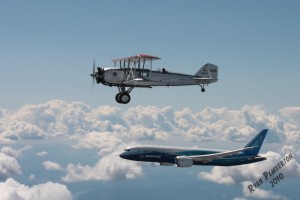
Boeing's oldest (Model 40) and newest planes (787 Dreamliner) flying together. Photo by Ryan Pemberton.
Here is the long awaited part 3 of my inside look at the Boeing Archive. I apologize it has taken so long to get this published.
In part 1 I took a look at what is inside the Boeing Archive. Then part 2, I took a closer look at some of the models in the Boeing archive. Now, I will post my interview with Boeing Historian Michael Lombardi. What is amazing is Lombardi did our whole interview from memory. I broke our interview it into two parts, with the second one posting tomorrow. Enjoy is our exclusive interview:
AirlineReporte (AR): How long have you been the Boeing Historian?
Michael Lombardi (ML): I’ve been doing the History thing for 16 years.
AR: You have to realize that you have one of the coolest jobs in the world, right?
ML: Well, I was sitting with Mike Carriker, Chief Flight for the 787 and I always joke that, well I have second best job in the world.
AR: How the heck did you get this job?
ML: I was really blessed to get this job and more of a case of being at the right place at the right time. The archives used to be with our technical libraries and I worked with them and the manager knew how much, like yourself, how much of a passion I had for aviation and having studied history and such and she said, ’œyou’d be great for this job. You need to go on and apply for it’. And I wasn’t even aware that the historian was retiring, so of course, I always thank this now retired manager profusely for doing this because I thought that was very forward looking and being a good manager and saying ’œhey, I think this employee would be a good fit for the position’.
AR: Do you have a staff?
ML: Yes, I have a very small staff. It’s me and Tom, and that is who’s here and we have a historian archivist in southern California and one in St. Louis. So there are four of us. Tom and I work for Boeing Communications and our two other historians work for the defense side of the company.
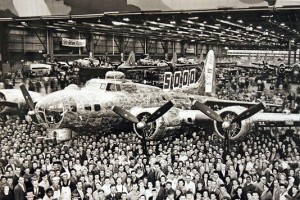
Employees gather with the 5000th Boeing B-17 made at Plant 2 in Seattle during WWll. Photo by Boeing.
AR: Knowing Boeing’s past pretty well, where do you see Boeing’s future?
ML: I think one thing you see is that the company will continue to lead the way as far as what’s the next step. And throughout history it seems that Boeing has introduced the products and technology or the innovations that have pretty much defined where flying is going to be, where travel is going, how airplanes are going to be used, or space vehicles. The company has been a leader throughout history and I don’t think that’s going to change.
AR: What is something that amazes you about Boeing?
ML: One of the things that always amazes me are the people that work here are so smart’¦ sometimes it just makes you say ’œwow’. And it makes you think, ’œHow can we not do the coolest things in the world?’ And then given with leadership that just says, ’œDo what you need to do and we’ll support you and give you the tools that you need and the support’¦’ and when you have that kind of leadership, the future is just completely open. I think it’s really cool.
AR: How do you think that William Boeing, the founder of Boeing, would view the company today?
ML: I think he would be very pleased with the company. His thing was that he wanted the company to constantly looking at new ideas and doing research, and doing development and always being at the forefront of aviation; bringing together all of the ideas and all of the newest ideas, and being a pioneer. That was a big thing for him. And I think that spirit it still here and that is what keeps the company going, it’s that pioneering spirit.
AR: Boeing used to run their own airline and many people ask, ’œWhy doesn’t Boeing have an airline today?’
ML: That’s a great question. A lot of it has to do with the laws about people who make airplanes shouldn’t be flying them too. So, that was pretty much it. In 1934 the government passed laws where the airplane manufactures couldn’t own airlines. So this kind of broke up what Bill Boeing had started.
It’s pretty amazing what he had done. They had the small airplane company here in the northwest in Seattle. And he was pretty successful but it was a small company, so what was the next big step? How do you expand this business and this is one thing to remember about Bill Boeing, is that he was a businessman. He wasn’t like a lot of pioneers out there that started the aerospace industry, a lot of them where engineers and some designers and they built an airplane and started a company. Bill Boeing looked at the airplane as a business.
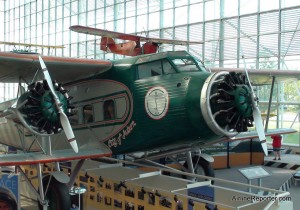
Boeing 80A-1 with "Boeing Air Transport" located at the Museum of Flight.
He was pretty visionary. You look at the articles of incorporation and he said that airplanes are going to be used for commerce, and for business travel, and passengers, and I want to have schools to train pilots and all of this. And at that time people looked at airplanes as a curiosity and there was no idea that you should fly an airplane on a trip and no one had conceived of that at that time.
You get up to 1927 and Bill Boeing decides to expand his business and goes into the airmail route, from Oakland, CA to Chicago, the biggest one in the country at the time. To do that, he had to give a low bid, and created the Model 40, which used an air cooled radial engine. Where other airplanes were water cooled and very heavy because they are carrying the water for the engine, the Model 40 was lighter and carried more mail, so Boeing won the contract. And this is the start of Boeing Air Transport. With that airline, he’s a businessman and he goes out and buys other airlines to make his airline bigger and then he’s like ’œwe need engines for airplanes’ so then he goes to Frederick Rentschler and says ’œI want Pratt & Whitney to become part of my company’ and they merge together. Everything under one roof. Great idea, right? And because of that Boeing goes out and builds airports and starts all these routes. There’s a couple other airline pioneer companies out there as well, but some of the things that Boeing did was design safety features and radios communication and ways to guide airplanes. Bill Boeing started this aviation infrastructure throughout the country and a lot of people forget that – that there really is a debt owed to Bill Boeing for doing that.
AR: Was there ever resistance to this new air-industry?
In 1934 you had a change in government, and of course the depression, and during the depression you have the airline industry just cooking along like nothing’s wrong and they’re making money and they are very successful’¦ so, they must be doing something illegal. Think about our recent history, which isn’t a whole lot different than back in the 1930’s, the car industry, the executives being called up in front of congress and those congressmen going ’œgrrr’ and the grandstanding in front of them. The same thing happened in 1934 but at that time you had Bill Boeing being rushed up there and being scolded.
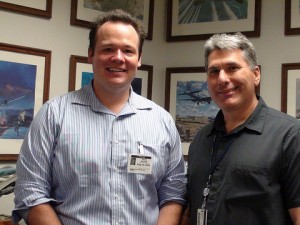
Mike Lombardi and me inside the Boeing Archives.
But at that time he had Charles Lindbergh, who is this public hero. You know the greatest guy in the world. American’s love him, and he gets up there and tells congress, ’œYou guys are all wrong. These guys have given you this wonderful gift of an airline infrastructure’, they have connected America with airplanes and you can go anywhere to do commerce and business, and this is something you need to thank them for. So that kind of stopped that whole bit. The result was they passed laws that said, they were going to break up these big holding companies. United Aircraft & Transport was broken up and because his big empire was being broken up, he just said ’œYou know, I’m tired of this. You hauled me in front of congress and you are calling me a liar’¦’ and he was a gentleman and a man of his word, very ethical. To call him this name was a very big offense to him and his character. And he said ’œI’m done with it’. And he’s already a rich man when he starts the company, this was business interest, it wasn’t his livelihood.
AR: It seemed really interesting to me that he got out pretty quick. He could have stuck around.
ML: He’s only around for about 18 years. He leaves the company and the company is broken up. You get the Boeing Company with the Wichita Stearmen division is made up into one part of the company. Everything on the east coast with Pratt Whitney, Sikorsky, and Hamilton Standard and all these other small companies like Chance Vought are all clumped together in this company called United Technologies. This is still around today. And then all of the airline interests are all previously called United Transport Corporation, are now called United Air Lines, which is now United Airlines. So these three big aerospace concerns that are still around and most of them are still very successful are companies started by Boeing. This is pretty amazing.
AR: It is amazing to think about how many companies have come and gone since then.
ML: The guy was really like the Bill Gates of his day. He was this amazing businessman.
Tomorrow I will post our interview where Lombardi talks about what he feels the best and worst decisions Boeing has made, as well as other interesting facts.
Inside The Boeing Company Archives
PART 1 | PART 2 | PART 3a | PART 3b | ALL PHOTOS | ALL STORIES
What is cooler than flying on a new Boeing 747-8F? Fly in it with no gravity. It brings up reminders of the ‘ol vomit comet.
Although this looks like fun, it is all about serious testing. Taking the aircraft to her limits to make sure she is ready to start flying cargo around the world. Although watching the test crew go weightless is pretty awesome, I think seeing the wing bend is unreal. Learn more from Boeing’s website about this test.
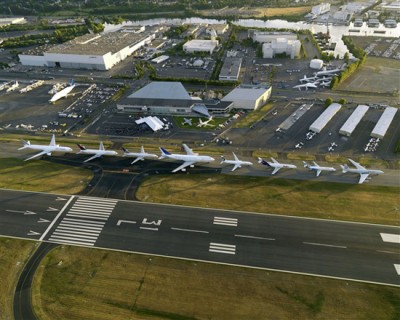
Boeing lined up one of each of their airliner models at Boeing Field. Photo by Boeing.
The other day I had an interesting conversation with @JetCityStar via Twitter about aircraft and museums. It turned into us asking each other if we could have one type of each aircraft Boeing made, which ones would we want. Yes, we are both airline nerds and proud of it.
Although the conversation is a bit on the nerdier side, I felt the conversation was worthy of a larger audience and was interested in what other people thought about which aircraft best represented a certain type. So I put the question to you. If you were a museum and could one of each Boeing airliner made, which would you choose?
Please put your answers in the comments. Here are mine:
Boeing 707: Test aircraft that Tex Johnson did a barrel roll in.
Boeing 717: Eh.
Boeing 727: Very first Boeing 727-100 made (which is being restored at Museum of Flight)
Boeing 737: Don’t ask me why, but I would really want a USAir 737-200.
Boeing 747: First Boeing 747 that was delivered to Pan Am. I just love the Pan Am livery on the 747, it just seems right at home.
Boeing 757: Probably one that was for the Vice President.
Boeing 767: The Spirit of Delta, which is housed in Atlanta.
Boeing 777: I am not even sure.
Boeing 787: ZA001 in her livery. Entering a new era or airliner.
WHICH ONES WOULD YOU CHOOSE?








